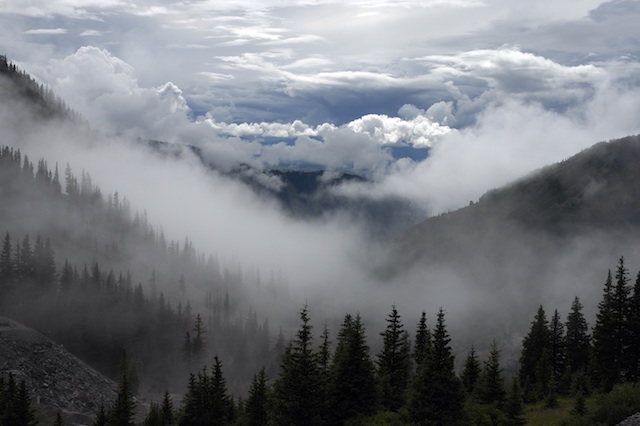It is six o’clock on this April morning when I first awake.
Fog has socked in the valley. Looking out the window from the warmth of the bed I share with my husband and Lab-Shar-pei, I notice a large and dark form outside. On any given day I have a clear view of the pine-forested southern ridgeline edging the valley.
Not today.
It takes me a few seconds. A bull elk stands statue-still, staring into the window. Next to him stand a dozen females–cows. Close by, a second young bull meanders, the lonely bachelor trolling for females at the ungulate cocktail party.
Munching freshly sprouted grass, they forage along the hillside. Elk are a peaceful presence. They move along in rhythm with their appetites. I watch the herd through the dampness of this particular springtime morning.
I love this time of year. The rain, snow and some combination in between–snain, I call it—falling upon the too-thirsty landscape. It has been a dry and windy winter. The softly falling rain is as comforting and long awaited as an old friend.
The land soaks in the wet like a body takes in a slow, deep breath.
A time out, a pause, from the dryness of any other day. The elk seem to sigh with mouthfuls of green, the chickadees greet the morning with their sweet mating call.
Living in the mountains means living close to Nature—not everyone has the constitution for it. Eight thousand feet above sea level, springtime elk herds or fresh-from-a-winter’s nap-bears in the springtime cause some to tremble nervously.
Some can’t breathe easily here. Others, pro-athletes—breathe even better. It’s all that extra hemoglobin.
Twenty-three years now, I’ve called this mountain valley home. Twenty-three winters, twenty-three springs.
Twenty-three summers and twenty-three autumns.
I hail from Chicago, another notable windy place. A former Midwesterner ventured west in search of the sun. Chicago is on a similar latitude as Colorado—it’s no wonder many of us wind up here. The year I moved I counted ninety-two days without sunshine. SAD—seasonal affect disorder—affects Chicago souls in the worst way; just ride the CTA downtown on any February morning, you’ll know what I mean.
People who move here from other places are often made to feel bad. Like we somehow shouldn’t be here. “Last settler’s syndrome”—close the door behind you before someone else gets in. It’s a real phenomenon in our nomadic country.
We’re all moving about the planet; hardly anyone is living where they took their first breath.
Neither are the elk staying put in their landscape. They are moving from higher altitude to lower. Triggered by the oncoming snowstorm this week, they are awareness on the hoof.
We too, are a migratory species. Often, on the move.
People are also made to feel vilified for their part in Nature. Separate from, as if we don’t belong.
And yet, we do. Woman/man have been here for millions of years. Australopithecus-afarensis, Homo habilis, Homo sapiens.
We’ve made our way alongside the elk to the culture we have today. Up here, you can feel the connection.
Last summer, my husband and me removed the old barbed wire fencing encompassing our pasture. After our 18-year old longhorn heifer passed peacefully (she often observed the elk migrations from the comfort of her barn stall), there was no more need for any fencing. A vestige of the previous landowner, we took down the square mile and rolled it up, tossed it into the back of the pickup truck, hauled it for recycling at the local dump.
We wanted the wildlife to feel they could pass through the land freely.
The danger of barbed wire is the threat it poses to wild animals. Pronghorn, deer, elk, moose—all jumping to clear several feet—often getting caught up in it. Sometimes, they catch a hoof, maybe even become ensnared.
It’s a hazard they don’t need in a world already challenging them to live well.
Today, this foggy April morning, they move about freely. All fourteen elk. We are on nine and half acres close to a state highway. We are part of the elk migration corridor—a few miles above and a few below. The obstacle of fencing has been removed, but there is one obstacle over which I have no control.
I can’t help this particular one. The elk herd will need to cross the highway. They need to keep moving through their habitat, down to lower elevations. I worry for them.
I crawl out of bed, following them from room to room on the inside of our small log home. They continue to forage outside. I stop in the northern portion of our home, a view out the kitchen window looking onto the mountainside.
I watch them roam northward in search of more green shoots edging the land—right next to the highway.
I feel blessed and excited they have come—we only get to see them like this once or twice a season.
Another feeling sets in—fear. Fear for their safety, fear for how quickly they can perish. Fear for the timing of any bad decision any one of them could make. Fear that their seasonal migration could be cut short.
I watch as the lead bull stops grazing suddenly. The herd raises their head, mouths full of green shoots.
He exalts his nose in the air, tilting his ears forward. He is listening for something.
Traffic.
The others freeze in observance. Holding reverence for the authority of his lead, they stand motionless. A car passes just then, the driver unaware of the dozen or so six-hundred pound bodies just feet from him. It is still foggy and soft rain continues to fall. And yet, expanding his peripheral vision to glimpse a herd of elk would prove helpful, if not lifesaving.
The lead male sets his left front hoof on the pavement. He jumps back with a start. I gasp as I continue to watch out the kitchen window. A second car shoots by, another sleepy driver at the wheel. It is still early—only 6:45am—commuting time, just beginning.
The driver is on his daily commute. The elk are on theirs.
The second car passes; the lead bull now takes a chance. A dozen cows and other bull follow. I breathe in a sigh of relief until a see a problem: There is one cow left behind. I watch the herd as they run like frightened schoolgirls across the highway.
I watch the lone cow left behind, spinning around in excitement. Her nostrils are flaring—she is anxious, wanting to follow. She is uncertain—and now, she is in danger. A trailing lone elk is vulnerable to traffic. Motorists can’t escape the sight of an entire herd—they can, however, miss just the one.
I want to help so badly. I cry in frustration. I can no more dash out our front door, flagging down traffic, than I risk scaring her right out onto the highway. Besides which, I never bothered to change out of my bedclothes, I was so captivated by the elk this morning.
Holding my breath, I wait. She turns and spins in front of me. The herd continues up the grassy draw on the steep mountainside the other side of the highway.
She leaps just then. Darting after the last wave of cars has gone; she saw her chance and took it. Animals risk their lives every day just to move through territories, get a drink of water and find a mate.
The suchness of mountain living is living with wildlife in mind. I’m attuned to the seasonal migrations of elk or the daily movement of the fox because I pay attention. It’s so easy to do. I accept I’m part of Nature. I learn so much more for giving pause and observing, my life feels different from the mainstream, a choice I made deliberately when I drove out of that Windy City twenty-three years ago.
I feel enriched. The elk have passed through our land this morning, and I woke up to a wet dark elk nose, just outside our bedroom window.
Nature informs a mountain lifestyle.
Author: Denise Boehler
Editor: Renée Picard
Image: Tim Mossholder/Unsplash







Read 0 comments and reply